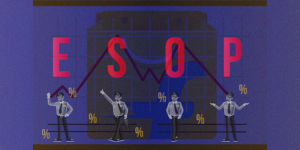Over the last 2-3 years, IndiaMART has spent more than Rs 900 crore on acquiring stakes in nearly 14 companies. These deals have helped the B2B ecommerce company strengthen its position across categories—HRtech with Zimyo, AI-powered freight movement with Fleetx, shipping solutions company Shipway, and of course, its most expensive buy—accounting software company Busy Infotech, which was acquired in January 2022 for a whopping Rs 500 crore.
These acquisitions are likely to spur IndiaMART’s growth in the next couple of years. “We estimate the proportion of revenues coming from new businesses moving from 0% in FY22 to ~10% in FY25E,” ICICI Securities said in its latest research report on the company.
Founded in 1999, Noida-based IndiaMART has now set itself an ambitious target—to double its revenue from a Rs 1,000 crore run rate at present to Rs 2,000 crore by 2027. This, it believes, can be achieved by further incremental improvement in ARPU (Annualised Revenue Per User), expansion into newer categories, and paid customer (subscriber) additions.
“Our search is better than Google, our B2B catalogue is better than Amazon,” Dinesh Agarwal, Founder and CEO, IndiaMART tells YourStory. “We do analytics and machine learning to improve search and match-making. Have price- and location-specific analytics. We focus on the sell side behaviour to improve consumer side matchmaking,” he adds.
As of 2023, the company commands over 60% market share in the B2B listings space. With a network of 7.4 million suppliers and over 90 million listings of products and services, it is now looking at further strengthening this position.
“The number of customers on our platform has been growing at 15%-20% per annum and our ARPU has been growing at 5-7% per annum. If you add that up, we are seeing a CAGR (Compound Annual Growth Rate) of 25% per annum,” says Agarwal. “At this rate, we would double our revenues every 4-5 years.”
IndiaMART clocked an operating revenue of Rs 251 crore at the end of Q3 FY23 on a consolidated basis, as compared to Rs 188 crore at the end of Q3 FY22.
The business roadmap
By taking the acquisition route, IndiaMART has been slowly expanding its ecosystem to go beyond discovery—towards financial accounting, logistics technology, and distribution or order management. At least four of its acquisitions have been in the accounting space—Livekeeping, RealBooks, Busy, and Vyapar. The company believes this could be a billion-dollar market, especially with small businesses needing tax and accounting assistance.
IndiaMART is also adding another layer of transactions to enable customers to place orders via the platform. Besides the ‘Pay with IndiaMART’ platform, it is now working on integrating logistics and tracking onto the platform. The management did allude to a combination of subscription- and transaction-based revenue models in the future on a recent investor conference call. However, it did not share exact details.
Along with the new business push, IndiaMART is also looking to make its existing product categories stronger. It operates in 56 industries, with the highest share of paying subscribers (about 8%) coming from industrial plants, machinery and equipment, and construction and raw materials.
“We are now working to make categories like agro and pharma mainstream. We are not good in consumer services categories as well,” said Agarwal.
“Our own product-market fit has become much better because we were left with nothing but to do deep work in each category (during the pandemic). I don’t think we have done such in-depth category work ever,” he added. Deep data mining and analytics helped the company understand areas of weakness and potential scale-up opportunities.
This has helped IndiaMART drive customer engagement and add more paid suppliers. The company added 6,600 paid customers in Q3 FY23 while 90-day repeat buyers stood at 54%. Going forward, it expects customer addition to be upwards of 8,000 quarterly while maintaining the churn.
Paid customers for IndiaMART have increased from 156,000 in Q3 FY22 to 194,000 in Q3 FY23. ARPU stood at Rs 49,400 in Q3 FY23 as compared to Rs 48,000 in the year-ago period.
“We expect INMART to deliver a 23% revenue CAGR over FY23-25, aided by sustained paying subscriber additions and strong growth in deferred revenue. We continue to see the company as a key beneficiary of the technology adoption by India’s MSME universe, as well as of a shift to a formalised ecosystem,” a recent research report by broking firm Motilal Oswal noted.
IndiaMART also wants to improve its presence in cities like Bengaluru, Hyderabad, and Kolkata, and also add more sellers from Tier II cities. At present, 55%-57% of IndiaMART’s paying customer base comes from the top eight metros and the rest are from Tier II cities.
Challengers in the market
The total addressable market of B2B ecommerce in India is poised for a CAGR of 55.8% over FY23E-FY25E, according to research by ICICI Securities. Given this market size, analysts believe that there is potential for two or more players to co-exist in the market.
While IndiaMART commands the largest market share, players like Udaan, TradeIndia, and Reliance-owned JustDial are also working aggressively to scale up.
“It is important to define B2B in ecommerce; it is a very broad term. When you say IndiaMART, Amazon (Business), etc., they are all very different businesses and target different customers. They are not solving the same problem,” said Agarwal. “All these businesses have the ability to expand into areas. They have found their own niche.”
At present, Just Dial has a 26% revenue exposure to the B2B ecommerce segment, with an approximate 15% market share. “We think this is likely to be the primary growth driver for the company and estimated to increase to ~36% of overall revenue by FY25E aided by growth in the segment,” according to a B2B ecommerce report by ICICI Securities.
As more MSMEs enter the digitisation fold, competition in the industry is heating up and players will have to strengthen their businesses within niches to be able to co-exist.










